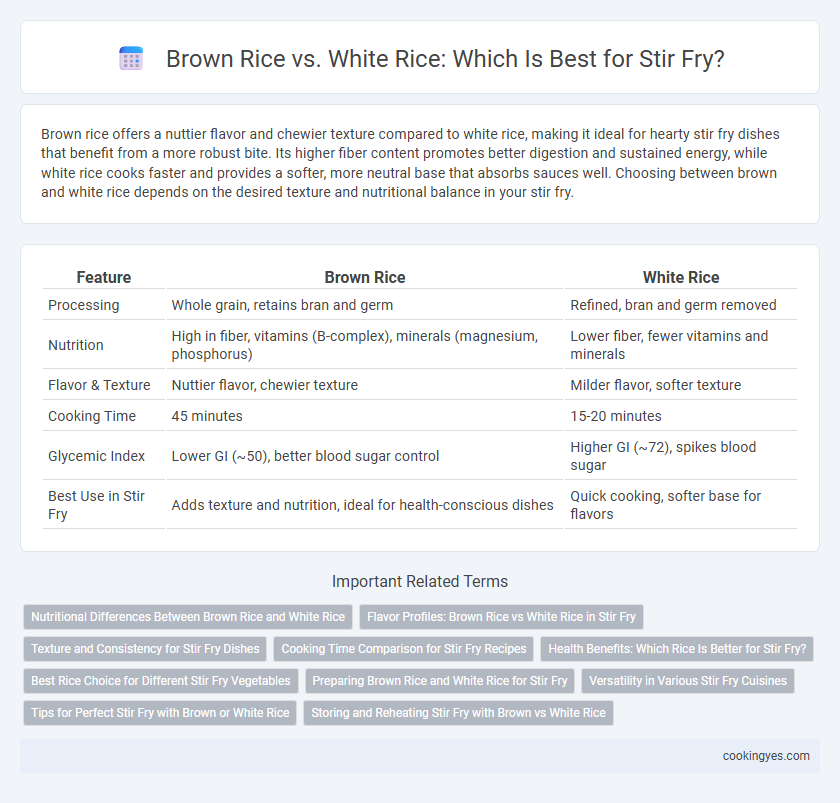Brown rice offers a nuttier flavor and chewier texture compared to white rice, making it ideal for hearty stir fry dishes that benefit from a more robust bite. Its higher fiber content promotes better digestion and sustained energy, while white rice cooks faster and provides a softer, more neutral base that absorbs sauces well. Choosing between brown and white rice depends on the desired texture and nutritional balance in your stir fry.
Table of Comparison
| Feature | Brown Rice | White Rice |
|---|---|---|
| Processing | Whole grain, retains bran and germ | Refined, bran and germ removed |
| Nutrition | High in fiber, vitamins (B-complex), minerals (magnesium, phosphorus) | Lower fiber, fewer vitamins and minerals |
| Flavor & Texture | Nuttier flavor, chewier texture | Milder flavor, softer texture |
| Cooking Time | 45 minutes | 15-20 minutes |
| Glycemic Index | Lower GI (~50), better blood sugar control | Higher GI (~72), spikes blood sugar |
| Best Use in Stir Fry | Adds texture and nutrition, ideal for health-conscious dishes | Quick cooking, softer base for flavors |
Nutritional Differences Between Brown Rice and White Rice
Brown rice retains its bran and germ layers, providing higher fiber content, essential minerals like magnesium, and antioxidants compared to white rice. White rice undergoes milling and polishing, which removes these nutrient-rich layers but results in a softer texture and faster cooking time. For stir fry dishes, choosing brown rice enhances dietary fiber intake and offers a lower glycemic index, promoting better blood sugar control.
Flavor Profiles: Brown Rice vs White Rice in Stir Fry
Brown rice offers a nutty, earthy flavor that enhances the complexity of stir fry dishes, providing a chewier texture that holds up well to bold sauces. White rice delivers a mild, neutral taste with a softer texture, allowing the stir fry's seasonings and ingredients to stand out prominently. Choosing between brown and white rice for stir fry depends on whether a heartier flavor or a subtler base is preferred.
Texture and Consistency for Stir Fry Dishes
Brown rice offers a chewier texture and nuttier flavor, providing a heartier consistency ideal for robust stir fry dishes. White rice delivers a softer, fluffier texture that absorbs sauces more readily, creating a lighter and more cohesive stir fry base. The choice between brown and white rice impacts the overall mouthfeel and integration of stir fry ingredients, influencing the dish's texture balance.
Cooking Time Comparison for Stir Fry Recipes
Brown rice requires a longer cooking time than white rice in stir fry recipes, typically taking 40 to 45 minutes compared to white rice's 15 to 20 minutes. The bran layer in brown rice slows water absorption, making it less suitable for quick stir fry dishes without prior soaking or pre-cooking. White rice's shorter cooking time and softer texture allow for faster preparation and better integration with high-heat stir fry techniques.
Health Benefits: Which Rice Is Better for Stir Fry?
Brown rice retains the bran and germ layers, providing higher fiber, antioxidants, and essential nutrients compared to white rice, which is milled and polished, stripping away these benefits. Its complex carbohydrates help maintain steady blood sugar levels, making it a healthier option for stir fry dishes aimed at balanced nutrition. White rice cooks faster and has a softer texture, but for maximizing health benefits like improved digestion and sustained energy, brown rice is superior.
Best Rice Choice for Different Stir Fry Vegetables
Brown rice offers a nuttier flavor and chewier texture that complements hearty stir fry vegetables like broccoli, carrots, and bell peppers, enhancing their natural earthiness. White rice provides a softer, more neutral base that pairs well with delicate vegetables such as snap peas, baby corn, and mushrooms, allowing their subtle flavors to shine. Selecting the rice type depends on the desired texture and vegetable profile to create a balanced, flavorful stir fry dish.
Preparing Brown Rice and White Rice for Stir Fry
Brown rice requires longer cooking time and more water compared to white rice, making it essential to soak or pre-cook it to achieve a tender texture for stir fry dishes. White rice, particularly jasmine or long-grain varieties, cooks faster and retains a fluffy, non-sticky consistency ideal for stir frying. Properly cooling both rice types after cooking helps prevent clumping and ensures even frying with vibrant texture and flavor.
Versatility in Various Stir Fry Cuisines
Brown rice offers a nutty flavor and chewy texture that enhances stir fry dishes across Asian, Caribbean, and Latin American cuisines. White rice provides a neutral taste and softer consistency, blending seamlessly with diverse stir fry ingredients and sauces. Both rice types adapt well to variations in heat levels, vegetables, and proteins, making them versatile staples for global stir fry recipes.
Tips for Perfect Stir Fry with Brown or White Rice
Use day-old rice, whether brown or white, to prevent clumping and achieve the ideal stir fry texture. Brown rice requires slightly more oil and higher heat to ensure even cooking and a crispy finish, while white rice cooks faster and absorbs sauces more readily. Incorporate fresh vegetables and protein, cooking them separately before combining with the rice for balanced flavors and optimal stir fry results.
Storing and Reheating Stir Fry with Brown vs White Rice
Brown rice maintains its texture better when stored and reheated after stir-frying due to its higher fiber and nutrient content, which helps retain moisture. White rice tends to become mushy and dry more quickly during storage and reheating because of its lower fiber content and softer grain structure. Properly cooled and refrigerated brown rice can be safely reheated without compromising flavor or texture, making it a practical choice for meal prep in stir-fry dishes.
Brown Rice vs White Rice for Stir Fry Infographic

 cookingyes.com
cookingyes.com